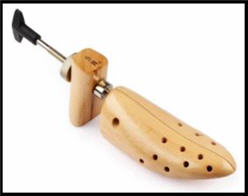Many players like to stretch a new pair of rugby boots before playing a competitive match.
But don’t believe everything you hear or read about how to stretch your footwear. The wrong advice can damage the material in modern rugby boots.
This article gives you our best recommendations. And we’ll point out some techniques to avoid!
Best Technique: Break Your Boots In Through Wearing Them
The technique we recommend is to stretch your boots by wearing them for short periods before you take to the field for an eighty-minute match.
Preparation
Before you put on your shiny new footwear, take these steps to get the best results:
- Put vaseline or petroleum jelly on your toes and heel to avoid blisters
- Wear your thickest socks or wear several pairs of socks
- Use lukewarm water and a sponge to lightly dampen the uppers
I’ve stressed that the water should be lukewarm.
You’ll see advice elsewhere to immerse your boots in hot water. Don’t do that! I’ll explain in a later section.
By the way, if you have tender feet – check our article on how to avoid blisters from rugby boots.
Wear them for short periods while training

If the season has begun and you have scheduled training, then the best option is to bring your old boots and the shiny new pair to the club training grounds.
Wear the new boots for 15 or 30 minute periods. Take them off if and when they start getting uncomfortable, and put them back on after a stint in your old boots.
A few training sessions should break them in properly.
Let your coaches know that you’re breaking in a new pair, so they’re not surprised to see you sitting on the sideline changing your boots at various intervals.
Use a local park or garden
If you’ve purchased the boots in the summer, then you’ll probably want to break them in before training starts back up.
A good option is to go for a thirty-minute walk on grass in a local park over several days.
If you don’t have a park nearby, then hopefully you can mow the lawn and do a bit of gardening for several thirty minute stints.
After you take them off
Your breaking-in tasks aren’t finished when you’ve pulled your weary feet out of the boots.
A good trick is to stuff new boots with scrunched up newspaper while they dry overnight.
Make sure you push the newspaper right down into the toe box. And then keep stuffing in more sheets until you’ve put pressure on the sides of the boots.
Other Good Techniques For Stretching Rugby Boots

There may be reasons why you can’t break your boots in by wearing them. You may want to wear them tomorrow for a competitive match!
So, here are some other techniques that are unlikely to damage your boots.
When we mention warm or lukewarm water, the point is that you should never immerse rugby boots in hot water. I’ll address that in the “Do Not Do This” section later.
These are the techniques that are preferable:
- use an adjustable shoe stretcher
- wear your boots in a lukewarm bath
- wear your boots in a lukewarm shower
- stuff your boots with newspaper
- stuff your boots with bags of water and place into the freezer
The next sections describe each technique in detail. Then we’ll finish off with a section on what not to do when stretching your boots.
Use An Adjustable Shoe Stretcher
Our parents’ generation were more likely to have shoe stretchers at the back of the wardrobe. You may be able to borrow two from your dad at short notice!
If you have access to a stretcher, you should also try to get hold of shoe stretch spray. This makes leather more pliable and improves the effectiveness of the stretcher.
There are several types of shoe stretchers. The best choices are for men’s boots. They will typically have two wheels to expand both lengthwise and width-wise.

When you insert the stretcher, make sure that the toe end touches the rugby toe box. Wiggle the stretcher heel to make it fit securely.
Then you can rotate the wheels to start stretching the tool. Be sure not to overstretch!
You should ideally leave the expanded boots for 24 hours. Try them on, and if they’re still too tight, then apply the stretcher again. This can take three days to get the right effect.
If you have good success, it’s worth investing in spray and stretchers. They’ll last years and will see you right for many pairs of boots.
Wear Your Boots In A Lukewarm Bath Or Shower
Put on your boots and get into a lukewarm bath or step into a lukewarm shower.
The water should soften the leather and the material will mold around your feet. The bath is probably preferable, as you can stay immersed for at least twenty minutes.
When you get out and remove the boots, I advise that you leave them to dry overnight with newspapers stuffed inside them.
Don’t do this repeatedly
I don’t recommend immersing your boots in water regularly.
This will slowly degrade the material and reduce the lifespan of your boots.
Cleaning and drying
If you use this technique, you will want to dry your boots in the way that best maintains their lifespan.
Check out our article on cleaning and drying your rugby boots safely.
Stuffing Newspapers Into Your Boots To Stretch Them
Stuffing your boots with newspapers is a technique that goes back to the nineteenth century.
This was probably even more effective with the type of leather used in boots in older times.
However, many players still swear by this tactic for stretching new boots for comfort.
The trick is to jam newspaper hard into the boots. Don’t gently drop a few crumpled sheets into the opening. Newspaper should be pushed right up to the toe block.
Keep jamming in more sheets until you can’t fit anymore.
I warned you not to overstretch your boots using the shoe stretcher tool. But you’re unlikely to be able to exert too much force with your hands as you push newspaper inside.
Stuff With Sealed Bags Of Water In the Freezer
The reasoning behind this technique is that water expands when it freezes.
You start by filling sealable watertight plastic bags with water. Shove the bags into your boots and place the boots into a freezer.
Leaving the boots overnight is more than enough time to let the water freeze. Eight hours is probably enough.
You may have a bit of trouble getting the bags back out of your boots! Just leave the bags and boots warm up a little, and you’ll be able to pry them out.
Be sure to use watertight bags
You don’t want the water-filled bags to leak slowly inside the freezer.
I advise that you don’t grab a worn plastic bag from the back of the cupboard and tie it with a hurried knot.
Use a Ziploc type of freezer back for this purpose.
Don’t do this repeatedly
I don’t recommend that you put the same boots into the freezer on a regular basis.
Boots are designed to play in wet weather. But they’re not designed for prolonged exposure to freezing temperature.
Things Not To Do When Stretching Your Boots
I’ve written this section on what not to do in response to some advice I see in other articles.
The advice may work for other types of boots and cleats made with different materials. But some of the advice could damage a rugby boot.
Do not submerge in hot water
Hot water can damage the adhesive material in your boots. That can cause them to start falling apart!
Do not apply hot air (e.g. a hairdryer)
Heated air can also damage the adhesive material.
It can also over-dry leather which can deform the material. You may find that the boots stretch into the wrong shapes!